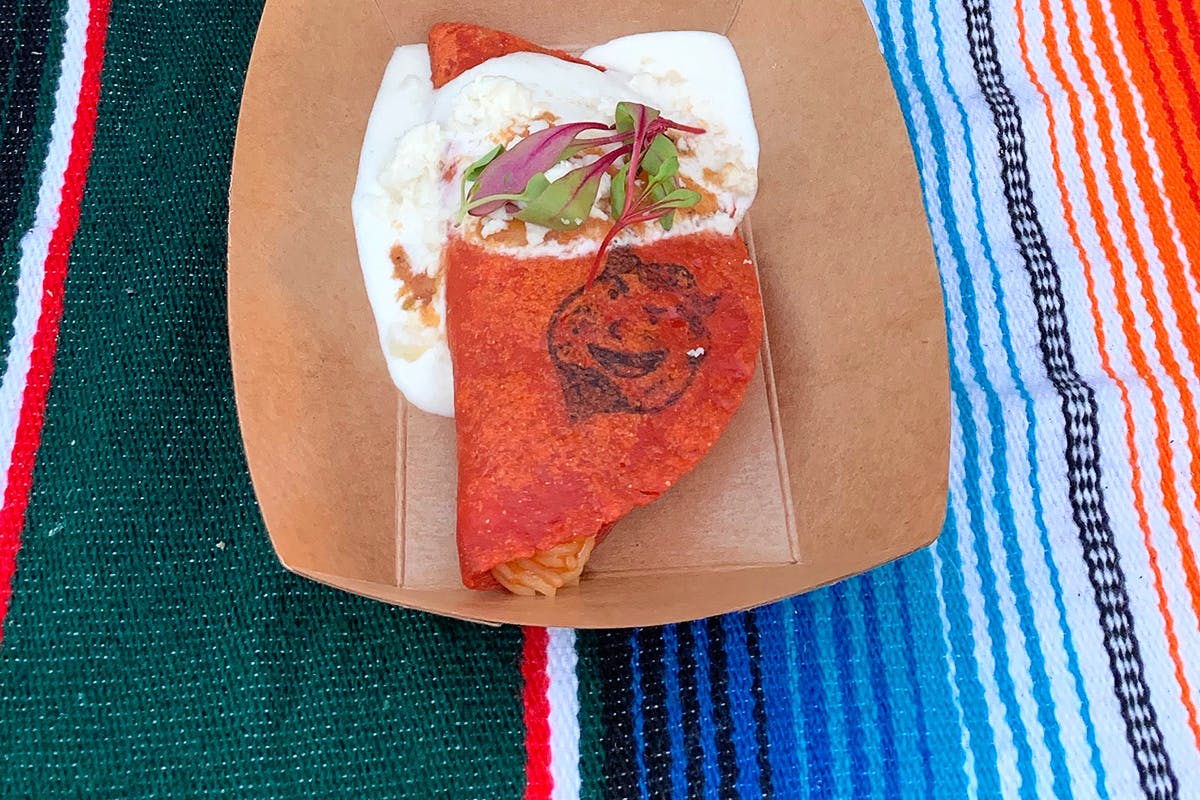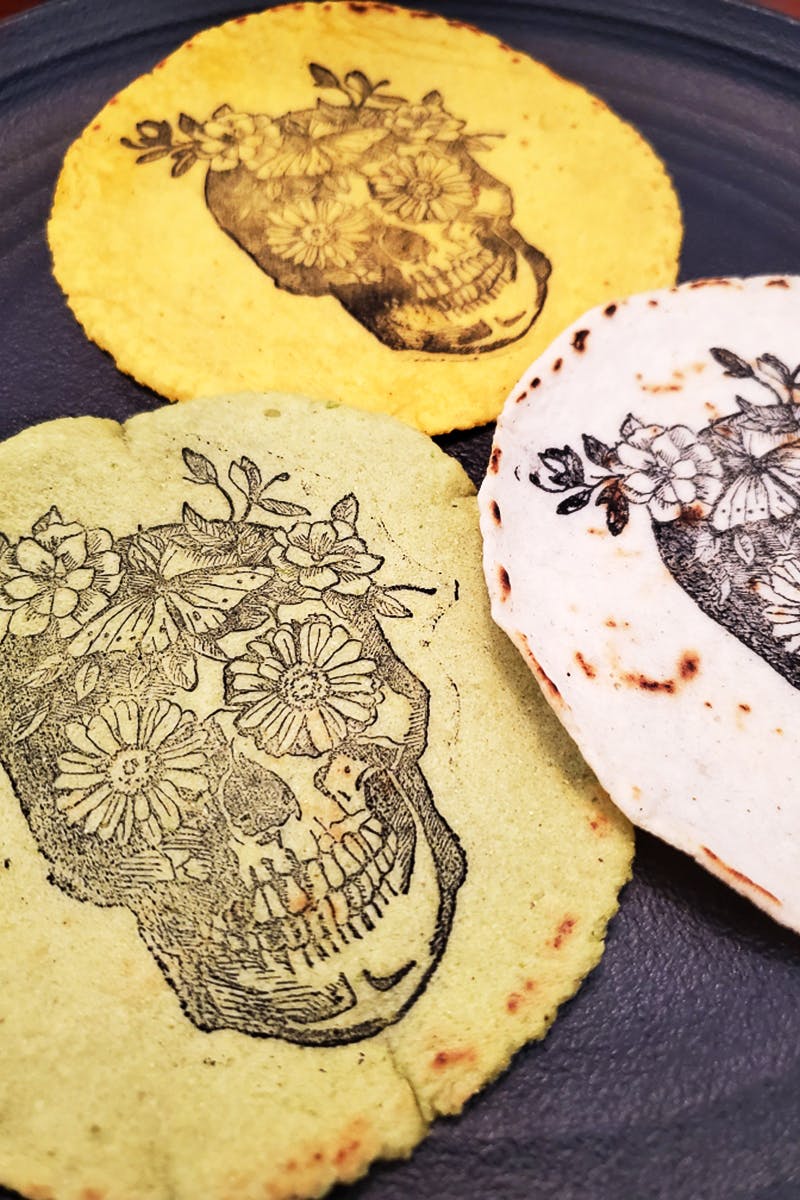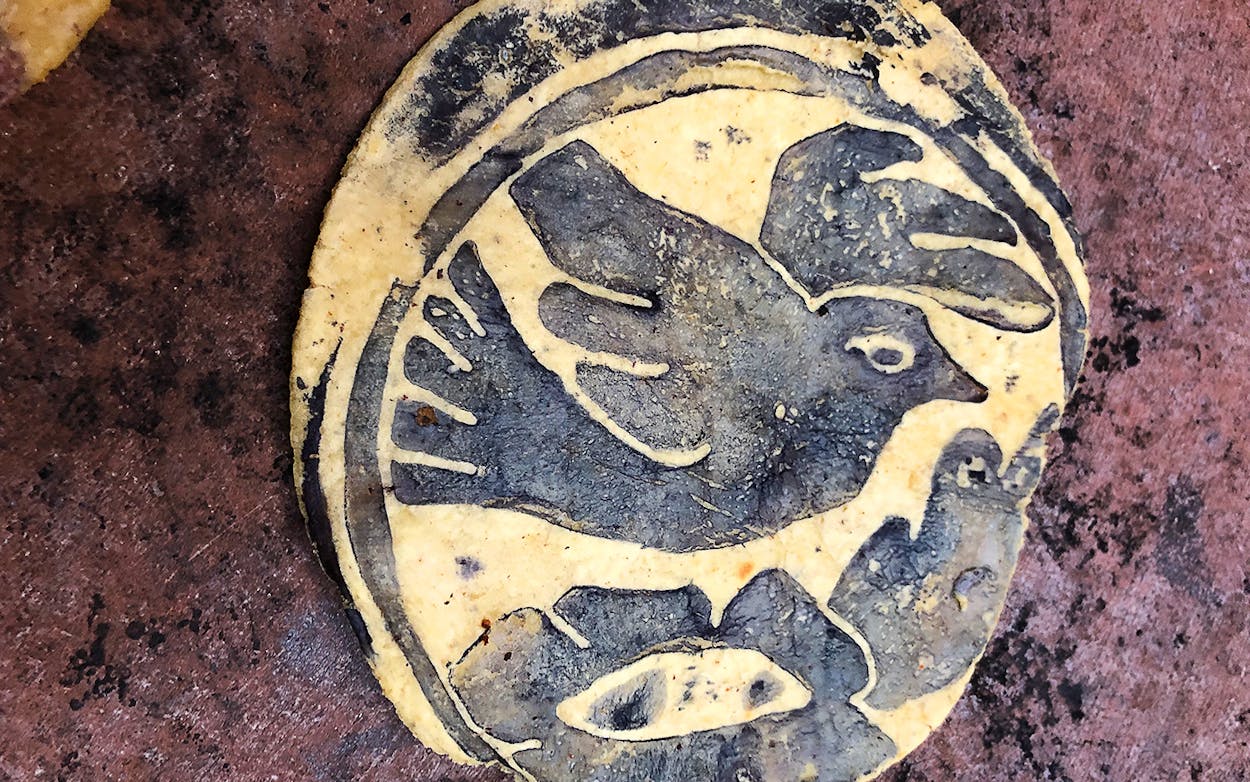When I was invited as a guest speaker to the 2017 World Forum of Mexican Gastronomy in Mexico City, I spent most of my time sampling the dishes proffered by the food hall stalls representing each of the country’s 31 states and one federal district. But at the Guanajuato booth, I encountered something I didn’t dare eat. It was simply too beautiful.
White corn tortillas decorated with a purple design—a bisected triangle with a laurel arched above it—covered the booth’s clay comal. These were, I learned, tortillas ceremoniales, also called tortillas pintadas (“ceremonial tortillas” and “painted tortillas”). They appeared to me like sacred objects.
First produced by the indigenous Otomí people of Mexico’s Guanajuato and Querétaro states, tortillas ceremoniales are for special occasions like Dia de los Muertos, weddings, quinceañeras, saint’s feast days, and other holidays. Stamps (sellos) imprint intricate patterns onto the tortillas in a natural, edible dye, like those made from Mexican honeysuckle or hibiscus, or from insects like cochineals.
Hugo Galvan, a native of San Miguel de Allende in Guanajuato and the corporate chef of Plano-based Reach Restaurant Group—whose establishments include Ojos Locos Sports Cantina, Pie Tap Pizza Workshop + Bar, and TacoLingo—remembers his grandmother making tortillas ceremoniales with a wooden stamp. “They were very rustic looking,” he said.

In October, I came across tortillas ceremoniales again, during the second installment of a guest chef pop-up series hosted by executive chef Anastacia Quiñones-Pittman at José, a modern Mexican restaurant in Dallas. This time around, the chefs were Alex Garcia and Elvia Huerta of Evil Cooks, a Los Angeles pop-up kitchen and vendor at that city’s Smorgasburg. Together, AQ (as Quiñones-Pittman is known in the industry) and Evil Cooks served several tacos. One of them was the trompo negro featured in Netflix’s Taco Chronicles. Another was a taco de fideo served in a tortilla ceremonial made of corn mixed with red bell pepper and bearing Evil Cooks’ mischievously smiling demon brand. The trompo negro was rubbed with recado negro, a complex paste of earthy spices, chiles, tortillas, vinegar, and other ingredients that left my lips feeling like they were caked with lipstick but was exquisite all the same. The taco de fideo, filled with slightly saucy vermicelli and dressed with a soothing crema ranchera, was comforting.
For Garcia, who grew up in Guanajuato and Querétaro but is not Otomí, the illustrated corn disc is something that connects him to home. “The Otomís used to come down from the plateau into town and sell their tortillas ceremoniales,” he says. “The tortillas were made with hand-carved wood stamps because the Otomís have so much respect for the earth. They would use natural dyes too, which changed depending on what colors they wanted.” A recent trip to Mexico brought back to Garcia memories of tortillas ceremoniales and led him to connect them to what he and Huerta are doing at Evil Cooks. “This is about more than making money,” he says. “What we’re doing is more like a celebration. Our concept basically is to bring some type of memory to you when you eat a taco from us. Incorporating the tortilla ceremonial is celebrating what we’re doing.”
They considered several designs, including traditional ones like stamps depicting a cactus pad. Ultimately they decided to embrace their own branding. “What better thing than to put our logo, right? When you see it, you remember us,” Huerta says. Instead of the natural dyes traditionally used in Mexico, Evil Cooks uses activated charcoal, which can be difficult. “You have to get the right consistency of the charcoal because if not it won’t work correctly. It can’t be too loose or too thick or the design will transfer to the other tortillas,” Huerta explains.
Seeing Evil Cooks’ tortillas ceremoniales inspired AQ to try her hand at them, under Huerta’s instruction. She worked on several designs. One featured a monarch butterfly on a calavera. “The first time I saw them was displayed in a restaurant in Oaxaca,” Quiñones-Pittman says, her voice filled with wonder. “I tried looking it up and learning about them, but I never knew. It was kind of a secret. No one wanted to tell you how they made them or where they came from or whatever. It wasn’t until Elvia [Huerta] was in the kitchen getting ready for the pop-up that I was like, ‘Oh my God, this is my chance.’ I was really, really, really excited. It’s another one of those things that you see other people do, and you want to respect their traditions, not straight-up copy them. I knew it would be a struggle because it’s such an intricate design.” Quiñones-Pittman served them with mole de olla, a stewlike mole with bobbing vegetables and aromatics, during Dia de los Muertos.

Iliana de la Vega, executive chef and co-owner of El Naranjo in Austin and a leader of culinary tours to Mexico City and Oaxaca, had never heard of tortillas ceremoniales until about six years ago, despite having a father from Guanajuato. She was intrigued when she first saw them in a book about corn. She got her own sello a few years ago. “It’s a simple one, but I was thrilled. I came back home [to Austin] and took it to the restaurant, just for the joy of it, to make tortillas and stamp them,” she says. At El Naranjo, de la Vega uses ground cochineal for the dye to imprint a crown design. “The ceremonial tortillas mean so much to the Otomís. They represent a celebration—something to be grateful for—just joy!” she says.
Rafael Ramirez, co-owner and executive chef at Café Alameda in San Antonio, first came across tortillas ceremoniales during his youth in Guanajuato, while attending the multiday Fiesta de los Gremios in the town of Comonfort. At his aunt’s house there, they ate mole along with tortillas ceremoniales. “I remember noticing the painting in the tortilla, which I initially thought were mole stains, but once I really looked at the tortilla, I noticed it had a saint’s figure,” Ramirez says. “I can’t recall what saint, but according to my aunt, the paint was done with a particular type of plant called muicle [Mexican honeysuckle], and the sello or stamp was made out of mesquite. I recall my aunt saying that the sellos were passed down from her grandmother and that her grandmother had received them from her mother, and so on.”
Gabe Erales, one of the three chef-partners at Comedor in Austin, was introduced to tortillas ceremoniales during a collaborative dinner with a chef from San Miguel de Allende. The imprints were of crosses, birds, and patterns of corn, vines, and beans because, as Erales says, “a lot of these were related to religion, honoring the family of the dead, and to commemorate harvesting for farming.” Although the guest chef used the traditional cochineal for the stamp ink, Erales employed ash from vegetable scraps. “Recently one of the things that I’ve wanted to do is get some of the maiz morado that I use from [Mexican corn purveyor] Tamoa because the cobs give off a nice purple pigment that can be used to make the markings on the tortillas,” Erales says.
Here is where tortillas ceremoniales connect us to a bigger issue: the modernization of Mexican cuisine in the United States driven by chefs embracing traditions as a way to push themselves and their food forward. One example is the embracing of nixtamalization of native Mexican heirloom corn for tortilla production. Tortillas ceremoniales likewise seem likely to increase in popularity north of the border. As this happens, it’s critical that we remember that they are not merely artisanal artifacts—they are expressions of a people’s cultural heritage.
- More About:
- Tacos
- San Antonio
- Dallas
- Austin








